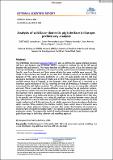Por favor, use este identificador para citar o enlazar a este item:
http://hdl.handle.net/10261/238664COMPARTIR / EXPORTAR:
 SHARE SHARE
 CORE
BASE CORE
BASE
|
|
| Visualizar otros formatos: MARC | Dublin Core | RDF | ORE | MODS | METS | DIDL | DATACITE | |

| Título: | Analysis of wild boar‐domestic pig interface in Europe: preliminary analysis |
Autor: | Fernández-López, Javier CSIC ORCID; Acevedo, Pelayo CSIC ORCID ; Blanco-Aguiar, José Antonio CSIC ORCID; Vicente, Joaquín CSIC ORCID | Fecha de publicación: | 2020 | Editor: | Wiley-VCH | Citación: | EFSA Journal 17(4): 1834E (2020) | Resumen: | The ENETWILD consortium (www.enetwild.com) aims at defining the spatial interface between wild boar and domestic pigs in Europe, which is essential to evaluate the risk for ASF spread between wild and domestic. This report describes the different sources of data for domestic pigs in Europe and develops a preliminary risk map of possible spatial interaction between both groups. Specific cases from Romania and Spain where reliable data were available were assessed. This model of the interface was based on the data from Gridded Livestock of the World (GLW) database of FAO, which provides predictions on a 1x1 km scale globally and the wild boar abundance distribution model recently elaborated by ENETWILD consortium (2020). The present available census data of livestock at the European Union level (Eurostat) is restricted to a maximum spatial resolution of NUTS2, remarking the need of developing a framework to collect harmonised data with higher resolution. This will ensure that data can be comparable, validated and used. There is need also to resolve definition issues regarding the pig production systems. Our prediction model of the interface between pig and wild boar at European level indicated that the maximum risk is scattered over Central Europe, large parts of Spain, north-east France and Romania. Hungary, so as Serbia and Croatia in the Balkans are at the highest risk in that area. In the specific case of Romania, no statistically significant association between census data of pigs collected from national authorities and predicted values was found when assessing the GLW model, evidencing that GLW predictions do not reliably represents the pig abundance distribution within countries. When assessing the interface model in Spain, certain areas of interaction were lacked, e.g. where extensive farming is relevant. The current discrimination of extensive vs. intensive farms of predictive models (GLW) is not reliable to perform analyses separately for each production system. The outputs this model of interface between wild boar and domestic pigs will guide future steps in both data collection and modelling approach. | Descripción: | ENETWILD consortium. | Versión del editor: | https://doi.org/10.2903/sp.efsa.2020.EN-1834 | URI: | http://hdl.handle.net/10261/238664 | DOI: | 10.2903/sp.efsa.2020.EN-1834 | E-ISSN: | 1831-4732 |
| Aparece en las colecciones: | (IREC) Artículos |
Ficheros en este ítem:
| Fichero | Descripción | Tamaño | Formato | |
|---|---|---|---|---|
| analysanalys.pdf | 6,06 MB | Adobe PDF |  Visualizar/Abrir |
CORE Recommender
Page view(s)
79
checked on 24-abr-2024
Download(s)
117
checked on 24-abr-2024
Google ScholarTM
Check
Altmetric
Altmetric
Este item está licenciado bajo una Licencia Creative Commons

